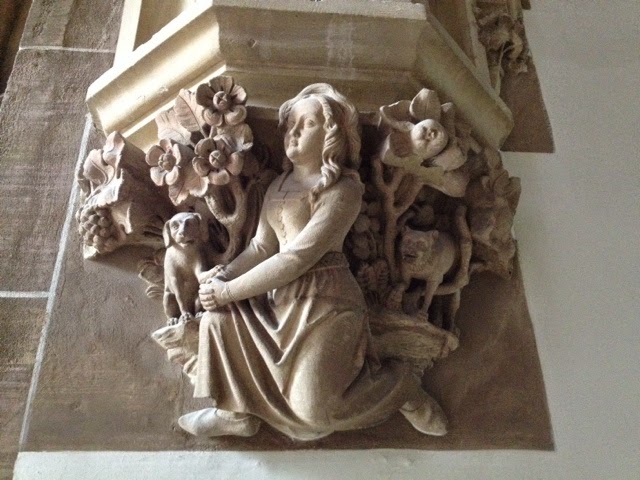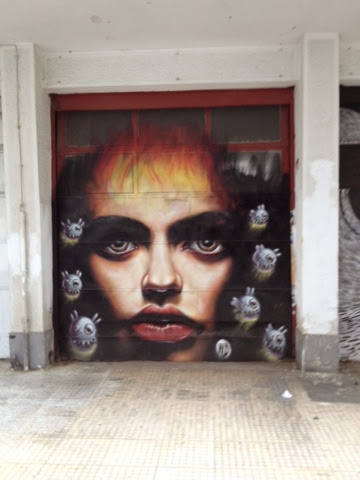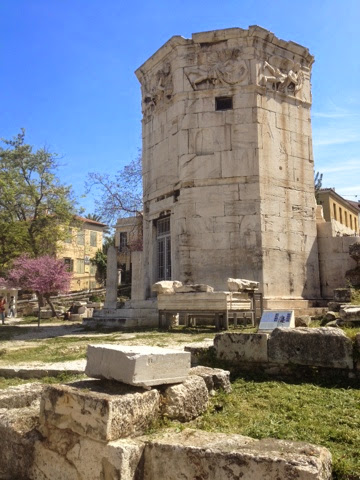Last time I came to Neuschwanstein, I skipped the residence of the last Bavarian royalty, a short distance away. The castle was initially built in the 1300's but the original castle had been destroyed during the Napoleonic wars. King Maximilian 2 rebuilt the palace according to the original plans; and the last Bavarian royalty, including King Ludwig 2 stayed here. Most of the palace is in its original state - and the paintings on the wall retain their amazing colour without requiring restoration. It's a beautiful palace, and well worth the stop.
About Me
- alapan
- I ramble about a number of things - but travel experiences, movies and music feature prominently. See my label cloud for a better idea. All comnments and opinions on this blog are my own, and do not in any way reflect the opinions/position of my employer (past/current/future).
05 April 2014
Neuschwanstein Revisited
It's amazing what a difference a guide makes. The guide for the trip this time around had a strong German accent, and a low voice - and the experience was far less engaging than my previous visit.
04 April 2014
High End Busking
Just behind Marienplatz (in Munich) I came across this group busking in the small garden. I have seen groups busking before, but never with a piano!
St. Paul's Church
After the Ancient Greek temples, even the cavernous neo-gothic St. Paul Cathedral in Munich feels a bit ordinary. Located near the fields hosting Oktoberfest, it is currently undergoing restoration, so visitors are not allowed up its main tower.
Unlike some other churches in Munich,the inside is quite plain - but the large cavernous hall does have its appeal. The friezes on the walls and columns feel quite amateurish after Greece, lacking the feeling of motion and majesty. But it is quiet and peaceful - and somewhat outside the tourist path (outside Oktoberfest time).
03 April 2014
Thoughts on Athens
The ancient world of Rome, Greece and Egypt were (and I think still are) staples of history class in school. I was (and still am) interested in mythology, and Ancient Greece was particularly rich in Mythology - from Hercules, to the Trojan War to the Iliad and The Odyssey.
When I set out on planning this trip, I had not meant to link all the places together - I wanted to go to Pergamon, but only after seeing the Altar in Berlin a few years ago; but I did not know the deep links the kings of Pergamon had with Athens. I wanted to go to Troy, because of the stories - but had forgotten of the links to Delphi. The trip has been amazing in linking all of these together; and although I did not complete the mythological world (for example, I couldn't fit in Crete) - I covered a great portion.
Of the ancient world, Athens has particular significance in being the root of the western civilized world; and it has lived up to its hype. Despite the economic crisis, Athens has endured - like it has endured countless other crisis before this one. And the Athenians it seems, have also endured. There are many shops that have closed down; but there are many more that remain open. Streets are busy, coffee shops and bars seem to be full in the evening, trains and busses are full - all the signs of a vibrant city.
But there is an economic crisis, and it does have its signs. There are more beggars here than any other European city I have visited. Occasional shops have crisis sales, indicating all is not well; and while things aren't as bad as Lesvos, it is clearly not all rosy. There were protests two evening before in front of the parliament; the police spent most of the day gearing up, and on TV it looked really angry. There was a small crowd there this morning, but apart from playing AC/DC on bad speakers, they weren't as noticeable.
But Athens does make a great, and cheap, holiday destination. The prices for meals and drinks are comparatively cheap to the rest of Europe. The hotels are equally cheap. It has great attractions, that are all within a small radius of the city centre. The people are very friendly, and willing to assist however they can.
And most of all, the attractions are cheap - too cheap in my opinion! The Acropolis ticket gives you access to almost all the other archeological sites, over 4 days an cost on 12 Eur. For comparison, Berlin's Museum Island pass for one day is 18 Eur! The museums are equally affordable; and prices for students and under 18s is almost free.
That said, the tourist experience can be better in some areas. Bus routes and times could be better marked; or perhaps provided online or on an app. Opening times for the museums and attractions are inconsistent - some are until 3pm others until 8pm; but it's not easy to say which one is till when. And more places could take credit cards - not talking about the kiosks in each street corner; but places like the Acropolis and airport metro stations.
There are things I would still like to see in Greece, so I would like to come back. And I hope Athens is as enjoyable then.
Public Art of Athens
Athens is full of graffiti and other street art; and some of this is probably commissioned by the shops or advertisers. Unlike Lesvos, I didn't see a lot of political protest art; which I found quite strange. The majority of the good art is around the Psyrri suburb; which also had a small Asian community (Bangladeshis and Chinese mainly it seems); but the art didn't seem to have any specific ethnic origin.
02 April 2014
The Sanctuary of Apollo at Delphi
The story of the Oracles at Delphi's Temple of Apollo, are well known. So many stories and myths have the oracles involved, it is one of the central pieces in Greek history.
Delphi fell into disuse fairly soon after Roman takeover of the Greek lands; and although a number of Roman emperors supported Delphi; once Christianity took root, it was soon forgotten. Unlike other sites, there were few conversions to churches and mosques; partly because the site was impacted by earthquakes.
This has also meant that the site is well preserved - there are seemingly more well preserved buildings and statues in this area than all the other ancient Greek sites we have visited this trip.
Delphi also neatly ties in some of the cities we visited on this trip - the demise of Troy was proclaimed by the oracles at Delphi; the serpent column that once stood at Delphi can now be seen in Istanbul (taken by Emperor Constantine) and the kings of Pergamon financed a few Delphi buildings and monuments.
Sadly, the highlight - temple of Apollo is one of the more badly preserved buildings. But the grandeur of the site remains - and if replicas of what is stored in the museum is put up; this site can almost bring back the heyday of Delphi from 2000 years ago!
The Sanctuary of Athena at Delphi
The lesser known temple and site at Delphi, the Sanctuary of Athena is a small site comprising of mostly ruins. It is most notable for Tholos, a round structure whose purpose remains unclear. It is an almost unique structure - and the many adverts for Delphi tours use this as their draw card. The site also offers a great view of the Sanctuary of Apollo.
Delphi Archaeological Museum
The many finds from both the main archeological sites and around Delphi are displayed at the Archaeological Museum, a few metres away from the entrance to the Sancruary of Apollo.
There are some stunning statues and friezes recovered from the sites; and the almost complete large statues are particularly impressive. The friezes have similar themes to the other temples of Ancient Greece, but are older and it has been interesting to study the contrast in quality. The best example is exhibited with the friezes related to the fight between the giants and the gods - earliest depictions in Delphi, later depicted on the Parthenon but the best is from the Altar of Pergamon (which is also the youngest, at around 300 BC).
The highlights are definitely the large statues, including the Sphinx, Argos Twins, the philosopher and the Bronze charioteer; all from the Sanctuary of Apollo. The architecture of the museum lets in a lot of natural light, which really enhances the experience.
The only criticism I have is really with the approach. By taking all the major finds away to the museum, some of the context of the size is lost. Thus, the fact that the Sphinx rested on a near 12m column in front of the Temple of Apollo looses the grandeur of the site. I think the Delphi sites should take an approach similar to that of the Acropolis, and put in replicas in the main archeological site - this way the original can be viewed closely and the grandeur and context of the site can be preserved.
Delphi
Delphi was out last stop in Greece, via a day trip from Athens. We decided to take the public bus option, instead of a tour mainly due to the cost - most tours advertise the day trip around 90 Eur per person and our trip including lunch was around that price!
The bus station in Athens is a bit difficult to get to via public transport and the hotel insisted that a taxi was the best option. On our return we discovered that the metro was not too far a walk; but probably not the best option at 7am in the morning. Incidentally, Athens at 7am was barely awake; a strange phenomenon considering South African rush hour starts at 6:30 am.
Delphi town is perched on a picturesque hillside overlooking a steep valley. Despite the bus loads of tourists, it was strange to see the town quite deserted. Many shops have already closed down and some are on "crisis sales". Somehow, the trickle down effect of tourism is just not working; perhaps because the tour operators are using other towns for lunch time stops; and there are not enough adventurous tourists using the public bus system.
01 April 2014
Lykavittos Hill
Rising behind the trendy suburb of Kolonaki, the hill is one of the highest points in Athens. On top, there is a small church dedicated (it seems to St George) and offers amazing views of Athens, proving that it is not only the ancient Greeks that knew where to build temples!
The 7 Euro funicular is quite expensive for the distance it covers, and its relatively limited service; but the walk up is steeper. The cafe on top is very reasonable in prices, which was surprising given its spectacular views.
Panathenaic Stadium
It's the site of the first modern Olympics, and is based on the design of an earlier stadium from antiquity, also located on the same spot. Unfortunately, it is no longer free entry; so we didn't go inside.
Day Light Saving Time and the Temple of Poseidon
The ancient Greeks really knew where to build their monuments and temples. In a small village outside Athens, called Suino, they built the temple of Poseidon on a cliff at the edge of the Aegean Sea. It is the same location where Aegeus is meant to have jumped off the cliff on the mistaken assumption that his son Theseus (who according to lend would go on to found Athens) died in his battle with the Cretan Minotaur.
The drama of going to and from the temple was worthy of the legends - we took a public bus, but it would only get is half way; whereupon we shared a cab with a Mexican father and son also going to the temple.
The temple itself is renowned for the colours during sunset; which has been around 6:30pm the last few days. With the last bus at 7pm, we thought we got it right; only to discover that due to daylight savings switch the day before, sunset was now at 7:45pm but the last bus was still 7pm. And the last bus, was late in arriving - but still ended up leaving only 5-10 minutes after 7; so the sunset was still missed at the temple.
All said, it was still an amazing sight. It is definitely worth the effort to go there - just don't rely on public transport to see the sunset.
31 March 2014
Ancient Agora
The Agora was the main meeting space for daily life; and the older Ancient Agora (built from 600BC onwards) was the administration centre. It was also the foundation of democracy - not only the proclamation of democratic process; but the council chambers and day to day bureaucratic processes associated with democracy.
Given the historical significance of democracy, it is strange that much of the Agora remains as ruins. The complex has two very well restored sections - the Stoa of Attalos which has an excellent museum on artefacts discovered in the area and a collection of statues; and the Temple of Hephaestus on the opposite side. In between, the site is mostly in ruins - a pity given its significance in the modern political world.
Roman Agora
The Agora was the hub of daily life - administration, market etc. The Roman Agora was the extension of the older Agora, and not much has survived - except the Tower of the Wind (used as anastronomical pobservation point) which is mostly intact.
Hadrian's Library
It's a building that has been destroyed, rebuilt, repaired or repurposed a number of times since it was built in 132/133AD by Roman Emperor Hadrian. Then, it was built as a library; but over the course of 1900 years, it has served the purpose of numerous churches, a cathedral, a mosque, fortification, administration centre, barracks, bazaar and more. Destroyed by pillagers of Athens and by earthquakes and fire, what remains is a testament to its size, massive walls and off course archeological restoration.
The size of its walls and remaining columns is impressive, but the highlight is definitely the mostly intact statue of Nike (Godess of Victory) carved from a single block of marble.
Subscribe to:
Comments (Atom)




















































